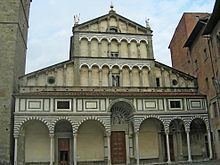Parishes 161 | Established 3rd Century Area 821 km² | |
 | ||
Population- Total- Catholics (as of 2004)217,515215,000 (98.8%) Ecclesiastical province Roman Catholic Archdiocese of Florence | ||
The Italian Catholic Diocese of Pistoia (Latin: Dioecesis Pistoriensis) is located in the Province of Florence. It has existed since the third century. From 1653 to 1954, the historic diocese was the diocese of Pistoia and Prato. The Diocese of Prato has been separate from 1954.
Contents
The diocese is a suffragan of the archdiocese of Florence.
History
The name of Pistoia appears for the first time in history in connexion with the conspiracy of Catiline (62 BC), but it was only after the sixth century that it became important; it was governed, first, by its bishops, later by stewards of the Marquis of Tuscany. It was the first to establish its independence, after the death of Countess Matilda, and its municipal statutes were the most ancient of their kind in Italy.
Pistoia claims to have received the Gospel from St. Romulus, the first Bishop of Fiesole. The first mention of a Bishop of Pistoia is in 492, though the name of this prelate, like that of another Bishop of Pistoia, referred to in 516, is unknown.
In 1653, Prato was made a diocese, and united, œque principaliter, with Pistoia; as early as 1409, Florence asked for the creation of a diocese at Prato, on account of the dissensions of the collegiate church of Prato with the Bishops of Pistoia; and in 1460, it had been made a prelatura nullius, and given, as a rule, to some cardinal, in commendam.
Diocese of Pistoia
Erected: 3rd Century
Latin Name: Pistoriensis
Metropolitan: Archdiocese of Florence
Diocese of Pistoia e Prato
Name Changed: 22 September 1653
Latin Name: Pistoriensis et Pratensis
Metropolitan: Archdiocese of Florence
Diocese of Pistoia
25 January 1954: Split into the Diocese of Pistoia and Diocese of Prato
Books
acknowledgment
This article incorporates text from a publication now in the public domain: Herbermann, Charles, ed. (1913). "article name needed". Catholic Encyclopedia. New York: Robert Appleton.
